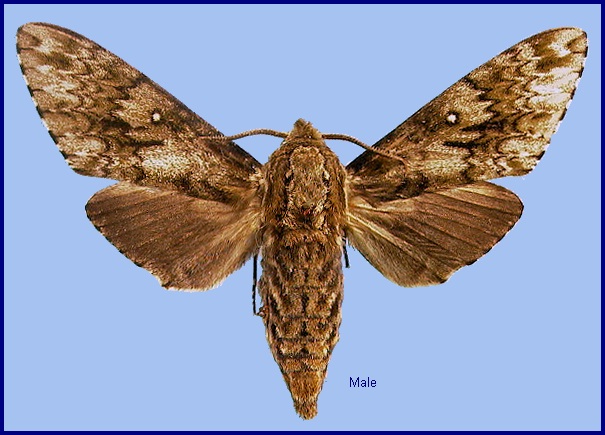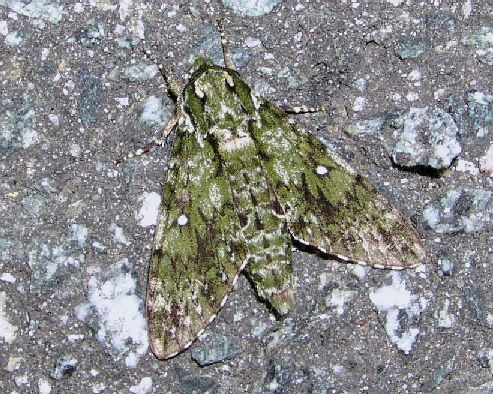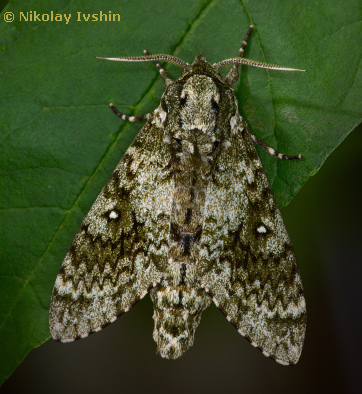

Dolbina exacta Staudinger, 1892, in Romanoff (ed.), Mém. Lépid. 6: 222. Type locality: [Russia, Khabarovskiy Krai] Bikin; [Russia, Amurskaya/Khabarovskiy Krai] southern Amur region.
Synonym. Dolbina parva Matsumura, 1921.
[Further details on this species in Japan, as well as photos of many stages, can be found on Digital Moths of Japan.]
Wingspan: 55--58mm. Both wings and abdomen undersides brownish grey. Abdomen underside with black basal spots very small, not generally visible. Pilifer with a brush of scales and a few bristles.
In the male genitalia, uncus broad, flat, downcurved, narrowed from midway to apex, which is incised. Gnathos with processes short and slender. Harpe with ventral process suddenly narrowed at apex to a point; dorsal process divided into a single distal and double dorsal lobe. Phallus with inner surface densely covered with sharp spines ventrally, forming a patch that extends proximad, the bases of the spines visible from the exterior; a small tooth present. In the female genitalia, ostial plate with processes very slender, and lateral to the plate, not anterior to it as in Dolbina inexacta.


An open parkland and forest edge species.
China: vii (Heilongjiang); ?14.vii (Hubei); ?21.vii (Zhejiang); ?viii (Shaanxi); ?4.viii (Beijing); ?12.viii (Guangxi). North Korea: vii (Baekdu-san); vii (Jueul). Japan: 3.vi (Hokkaido); 7.vi-18.viii (Honshu); 7.vii-19.viii (Hokkaido). Russia: 2-16.vi (Primorskiy Krai); 2-28.vii (Primorskiy Krai); 5-24.vii (Khabarovskiy Krai); vii-viii (Primorskiy Krai); 11-23.viii (Primorskiy Krai).
Park et al. (1999) give mid April until late August as the flight period in Korea.
OVUM:

LARVA: Full-fed 70 mm.; breadth 11 mm.; horn 8.5 mm. In the final instar head shortly triangular, a little higher than broad. True clypeus one-third length of head, each basal angle with a small tumidity. False clypeus with acute apex reaching to one-half length of head. Labrum less than half length of clypeus; ligula as long as labrum. Surface dull, set widely with small, low tubercles. Body gently tapering frontad from segment 7. Horn long, straight, thick at base and tapering evenly to a fine point. Secondary rings of segments 2 to 4 raised into ridges on dorsum. Horn covered densely with small pointed tubercles. There are large, round, closely-set tubercles on the anal flap and claspers.
In most, the head is greyish-green with a broad, pale yellow cheek-stripe from vertex to base of antenna. False clypeus dark green; labrum and ligula rust-coloured; basal segment of antenna dark brown, other segments rust-coloured; mandible dark orange with tip black. Body greyish-green with a glaucous suffusion on dorsum. Oblique lateral stripes white or pale yellow, edged frontad with apple-green for part of their length, with each crossing two segments. Horn, anal flap and claspers apple-green. True legs pale orange, base rose-coloured; prolegs green. Spiracles reddish-brown with a white central slit widening slightly at top and bottom, the whole ringed with yellow, oval in shape and flush. In some specimens there are carmine patches round the spiracles, above the oblique stripes and at bases of true legs. In this form the basic body colour tends more towards apple-green, the oblique side stripes towards yellow. Each form becomes intense reddish-purple dorsally prior to pupation.




PUPA: 40--48 mm; breadth 14 mm. Colour chestnut to blackish-brown, the bevels of the free abdominal segments paler; the spiracles brown. Smerinthine in shape, rather like that of Marumba dyras, thickest in the middle. Shoulders evenly rounded; dorsum of segment 2 very steeply inclined, rising nearly at right angles to the axis of the body, the dorsal line of 3 being nearly parallel with the axis. Tongue equal to fore leg, reaching to about the middle of wing-case; mid-leg longer, antenna slightly longer than fore leg. There is no coxal piece. Surface shiny, irregularly corrugate on the head and thorax, elsewhere pitted with coarse shallow pits, except on wing-case. There are weak ante-spiracular ridges on segments 8 to 10, in the form of three short parallel ridges on each. Spiracle of segment 2 crescent-shaped; the remaining spiracles oval. Cremaster stout, bulbous when viewed laterally, ending in a short bifid tooth. The dorsal surface very rugose except for the tooth, which is smooth.
Larval hostplants. In Primorskiy Krai, Russia, on Fraxinus and Syringa amurensis (Graeser, 1888; Derzhavets, 1984), and in Japan on Fraxinus lanuginosa (Sugi, 1987).
Izerskiy (1999b) gives Fraxinus mandshurica and Syringa amurensis for the Russian Far East.
Recorded in Korea on Ligustrum obtusifolium, Syringa reticulata and Fraxinus rhynchophylla (Park et al., 1999).
Unknown.
China: Heilongjiang (Harbin); ?Beijing; ?Shaanxi (Feng Xian); ?Zhejiang (Tianmu Shan); ?Hubei (Shennongjia); ?Sichuan; ?Hunan (Dayong); ?Guangxi (Liuzhou).
North Korea: North Hamgyong Province (Jueul, 1500m; Baekdu-san, 2500m); South Hamgyong Province (Nangnimsan); Kangwon Province (Keumgang-san).
South Korea: Baengnyeong-do & Daecheong-do; Kyonggi Province (Suri-san; Gwangleung; Chukryong-san; Soyo-san); Kangwon Province (Pungtung; Samak-san; Seolak-san; Jeombong-san; Yangyang; Bangtae-san; Balwang-san; Chiak-san; Taebek-san; Odae-san; Hwacheon; Chuncheon; Yaksu-san); North Chungchong Province (Songni-san; Chupunggryung; Minjuji-san; Wolak-san); North Cholla Province (Jiri-san; Naebyun-san; Namwon; Muju); South Cholla Province (Baekyang Temple; Jin-do; Dolsan-do; Gwangyang; Gurye; Yeocheon; Haenam); North Kyongsang Province (Seondal-san; Sobaek-san; Juwang-san; Naeyon-san; Gunwi; Cheongrang-san; Seongju; Youngcheon; Cheongdo); South Kyongsang Province (Baekun-san; Gibaek-san; Yeohang-san; Muhak-san; Gaeam-san; Geoje-san; Geochang; Goseong; Gimhae; Namhae; Sacheon; Sancheong; Yangsan; Ulsan; Jinju; Tongyoung; Hadong; Hamyang; Hapcheon); Cheju Province (Sungpanak; Cheju-do; Seoguipo; Suakbong; Hare-ri; Halla-san; Namwon; Wisseorum; Ara-dong; Haean-dong).
Japan: Hokkaido (Kushiro; Tokachi; Noboribetsu; Kamikawa-cho; Monbetsu); Honshu (Tokyo; Kyoto; Onyu; Takefu; Kumanotaira; Mikaboyama, 750m; Naka-Karuizawa; Shinbo; Iruma; Yashajin Pass; Akashina; Asagiri-kogen (Kishida et al., 2018)); Shikoku (Saijo); Kyushu.
Russia: Khabarovskiy Krai (Bikin; Slavjanka); Primorskiy Krai (Andreevka; Bukhta; Vladivostok; Khasan; Ussuriysk; Jankowski Peninsula; Kedrovaya Pad Nature Reserve; Kirovskiy; Vityaz Bay; Novovladimirovka).
Confirmed from the southern Russian Far East, Japan (Komatsu & Inoko, 2000) and the Korean Peninsula (Kim et al., 1982), south into China as far south as Harbin, Heilongjiang. Records from Hunan (Wang, 1992) and Guangxi (NAUY) require verification, as do those from Sichuan, Hubei and Zhejiang; these are probably other species of Dolbina.
The two male specimens recorded from the Kurile Islands (Kunashir Island) by Rybalkin & Yakovlev (2017) have since been confirmed to be Dolbina tancrei Staudinger, 1887 (Rybalkin, Benedek & Dubatolov, 2022; Vladimir Dubatolov, pers. comm. 2023).

Holarctic; eastern Palaearctic region. Pleistocene refuge: Polycentric -- Japanese and Sinopacific refugia.
 Return to Sphingidae of the Eastern Palaearctic species list
Return to Sphingidae of the Eastern Palaearctic species list